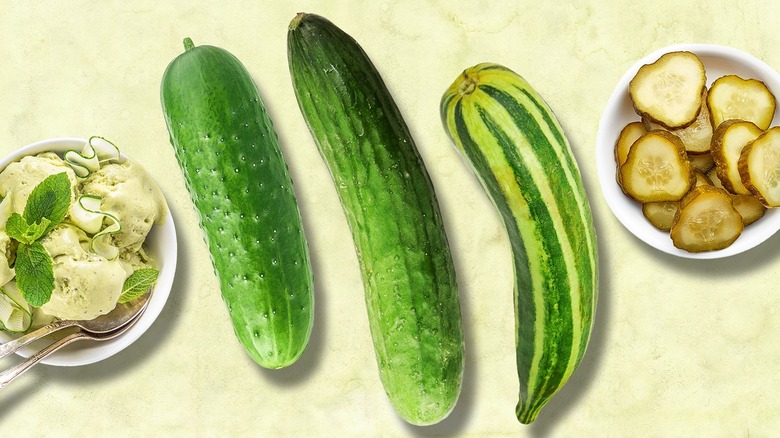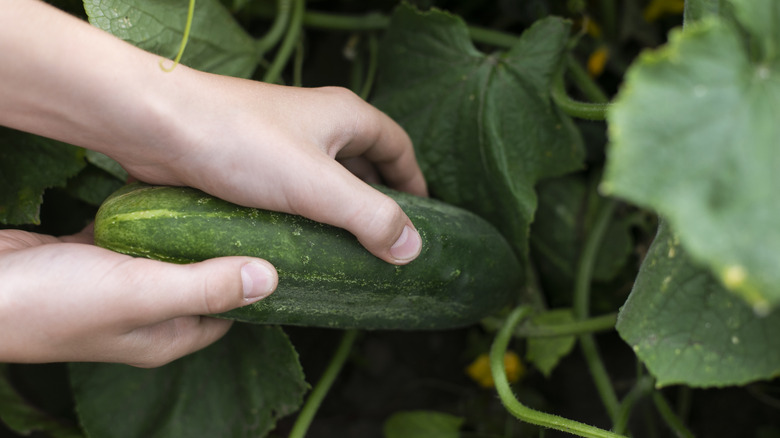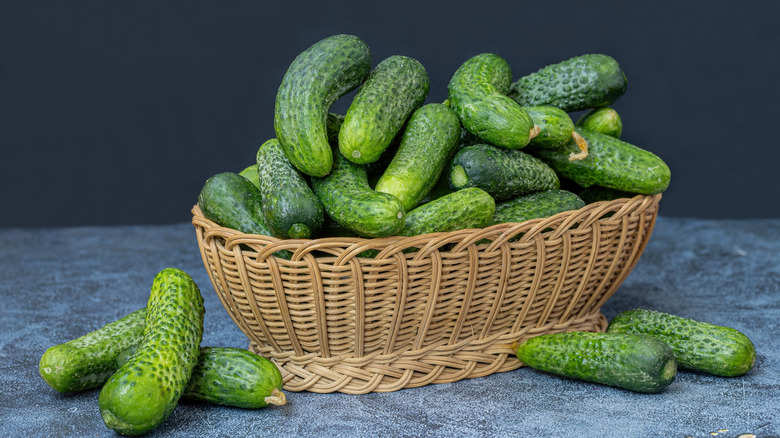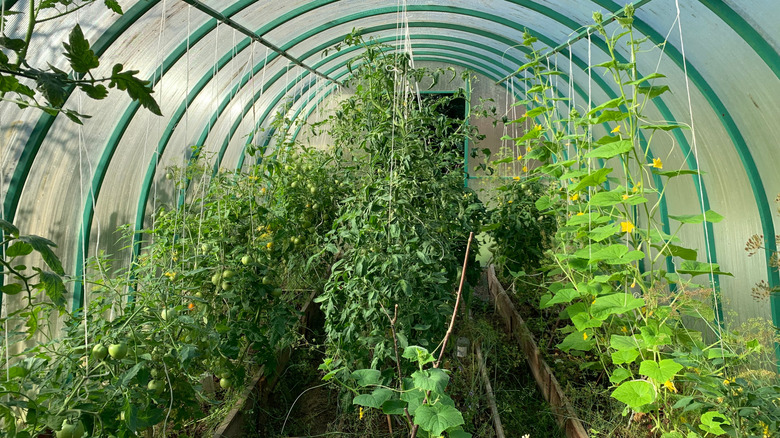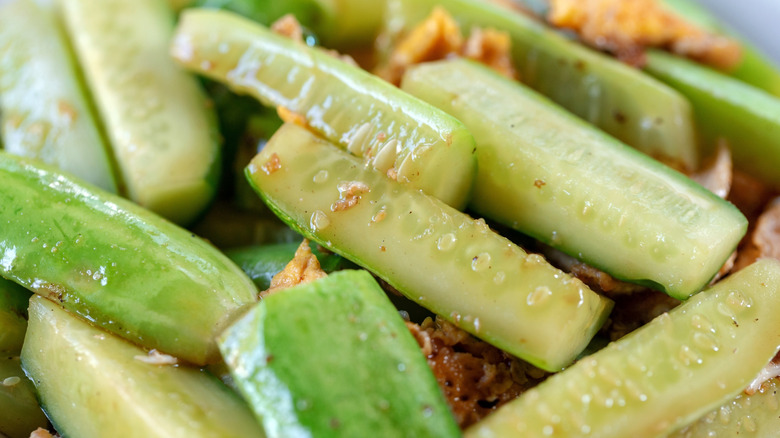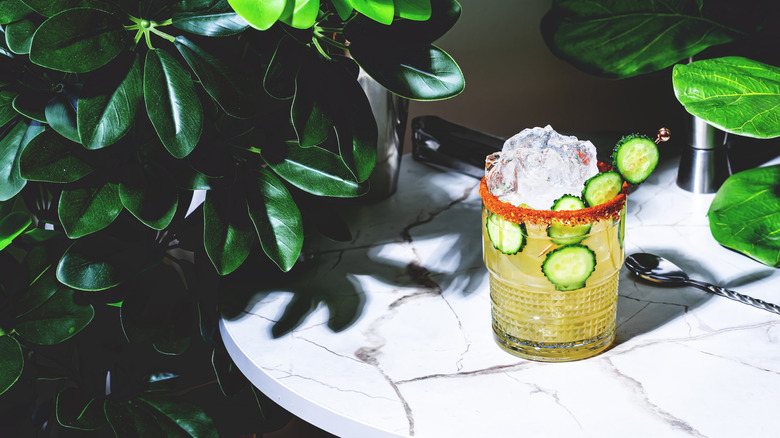10 Facts About Cucumbers Everyone Should Know
Cucumbers are one of the world's favorite foods. In fact, in the U.S, people eat more than 8 pounds of cucumber every year, per Statista. The plant's popularity has been bolstered even more in the last few years, largely because of TikTok trends for cucumber salads and spiralized cucumbers. In 2024, the social media app was even blamed for cucumber shortages. In Iceland, for example, grocery stores struggled to keep up with the soaring demand.
If you love cucumbers, you might be interested to know that there is more to this humble ingredient than meets the eye. For instance, while you might think that cucumbers are a vegetable because of how they're used in most popular recipes, they're technically a fruit. Did you also know that a cucumber's appearance can tell you a lot about how it's going to taste? And that they were once enjoyed by ancient Egyptians and beloved by English royalty? If you want to learn more about cucumbers, below we've listed some of the most interesting facts about this tasty, cooling plant that we think everyone should know.
A cucumber is actually a fruit, not a vegetable
Most see cucumber as a vegetable, and it makes sense. First, there's the dark green appearance, which is similar to other vegetables, like kale, arugula, or spinach, for example. Then there's the taste: They have a mild, earthy flavor, which is only a little bit on the sweet side. And then, of course, there's the way they are consumed, which is usually in savory dishes, such as salads, wraps, burgers, and sandwiches. But while they are often treated like vegetables, cucumbers are technically fruits. They belong to a family of plants called Cucurbitaceae. Known as the gourd family, this species also includes watermelon, pumpkin, and zucchini. All of these plants (yes, even zucchini) fit the botanical definition of a fruit. This is because they grow from flowers and contain seeds. Vegetables, on the other hand, do not grow from flowers. Instead, they are one of the main parts of the plant, like the root, leaves, or the stem, for instance.
That said, if you were to enter a restaurant kitchen and speak to a chef, they would probably tell you that a cucumber is a vegetable. This is because in the culinary world, fruits and vegetables are usually separated by how they are used rather than their genetic makeup. A cucumber wouldn't be used in an ultra-sweet dessert like other fruits, for example, so in this setting, its mild earthy flavor and crunchy texture puts it in the vegetable category.
The best-tasting cucumbers are usually dark green all over
Is there anything more frustrating than buying a cucumber only to find that it's actually a little squishy and soft when you go to eat it rather than crispy and crunchy? Okay, so there are more frustrating things than a bad cucumber, but it is undeniably annoying. The good news is there are ways to reduce the chance of this happening. When you're selecting a cucumber at the market or the store, for example, it's important to pay close attention to the color of the cucumber.
If you're buying a garden cucumber, which is the most common variety in the U.S., you should look for one that has a uniform dark green color all over. If it has yellow spots, it's best to avoid, as this means the cucumber is probably too ripe. Overly ripe cucumbers are still edible, but they won't taste as good fresh, as they tend to be softer and more bitter. They're best suited to pickling rather than for adding to your favorite summer salad. The best-tasting cucumbers will also feel firm to the touch, have a smooth texture, and feature nice rounded ends. You should also pay attention to size. In this case, bigger is not always better. Smaller cucumbers tend to have a sweeter taste and a crispier texture.
There are around 100 varieties of cucumber
As mentioned above, the most common cucumber in the U.S. is the garden cucumber, but this is far from the only cucumber variety. In fact, there are likely around 100 different types of the plant, and the type people are most familiar with depends on where they live. In India, for example, malini cucumbers are popular. This particular variety of the fruit is a hybrid variety, which means it has been carefully bred from two different types of cucumber. Malini cucumbers are dark green, similar to a garden cucumber, and they are also crisp, sweet, and perfect for salad dishes. In the UK, you have English cucumbers, which are the most common variety,and they are long, thin, and mild. They also contain very few seeds. In France, cornichon cucumbers are particularly popular. Unlike the other cucumbers, cornichons have bumpy skin with a slightly tart flavor. However, they are still crunchy and juicy, especially when eaten fresh.
Other common types of cucumber eaten around the world include Persian cucumbers (which look and taste a lot like English cucumbers), Kirby cucumbers (which are bumpy and small), gherkins (perfect for pickling), and lemon cucumbers. The latter is likely the most unique variety of cucumber, named for its round, yellow, lemon-like appearance and sweet taste. It's important to note that not all cucumbers are suitable for eating. Wild cucumbers, like Melothria pendula (also known as Guadeloupe cucumber or creeping cucumber), for example, are considered mildly toxic when ripe and may cause diarrhea if consumed.
Cucumber skin is packed with nutrients
Cucumbers are a beneficial addition to most people's diets. For starters, they're about 96% water, which means they are a good source of hydration (this is particularly beneficial in the hot summer months). But they also contain nutrients like vitamin C, vitamin K, magnesium, potassium, and fiber. To get the best nutritional value, it's important to leave the skin of your cucumbers.
If you peel your cucumber, you'll lose most of the fiber, which is an essential nutrient for digestive and bowel health. Cucumber skins contain two different types of fiber, insoluble and soluble, both of which are beneficial for the body. Removing the skin also means losing a substantial amount of vitamin K, which is present in many green vegetables and is important for helping blood to clot. In fact, cucumber with the skin on contains around 41% of the recommended daily amount of Vitamin K, while cucumber without the skin contains around 17%
On top of this, cucumber skin is also a good source of antioxidants. These are plant compounds that help to tackle and reduce free radical damage in the body. Over time, free radical damage can increase the risk of health conditions like heart disease and cancer. If you're concerned about chemicals such as pesticides on the skin of your cucumber, make sure to give it a thorough wash before you start preparing your food. You can also clean it with a vegetable brush, or soak it with baking soda.
Poor growing conditions can make for bitter cucumbers
Cucumbers usually have a mild, sweet, and earthy taste, but sometimes they can be too bitter. This is down to a compound called cucurbitacin, which is present in all cucumbers, as well as all of the other members of the gourd family, like pumpkin and zucchini. For the most part, cucurbitacin is present in the leaves or stems of a cucumber, which are the bits we don't typically eat, so it's not really a concern. However, when cucumbers are grown in poor conditions, this can lead to more cucurbitacin in the actual fruit of the plant (that's the bit we eat).
Extreme heat, for example, can impact the taste of a cucumber. However, this can be resolved by making sure the cucumbers have enough moisture. However, over-watering can also make a cucumber taste too bitter. So, if you're growing cucumbers from home, try to make sure you water them regularly, but not enough for the soil to become waterlogged.
Some cucumbers are simply more prone to bitterness than others. If you're looking for a less bitter cucumber, pay attention to varieties that are labeled bitter-free or burpless, like Green Knight, Tasty Green, or Carmen. These types have been cultivated to have a milder, sweeter flavor. Note that while some have turned to the process of milking cucumbers to make them less bitter, which involves slicing the ends and rubbing them to draw out the white cucurbitacin inside, this method has been debunked by experts.
Cucumbers have a long and fascinating history
Cucumbers are a staple ingredient in many different dishes today, but they're far from new. In fact, this edible plant (which likely originated in India) has been eaten for a very, very long time. There is evidence that they were consumed in ancient Egypt, for example. Back then, they were usually harvested from the wild alongside vegetables like garlic, leek, onions, and celery. They were also eaten in ancient Rome and, reportedly, were loved by the Roman Emperor Tiberius in particular. In fact, some speculate that Tiberius' love of cucumbers might be why greenhouses were initially invented, so that he could always enjoy his favorite food, regardless of the season.
In the centuries that followed, cucumbers only became more and more popular around the world. Research suggests Charlemagne grew them in France throughout the ninth century, and Christopher Colombus introduced them to South America and Haiti in the 1400s. In the 16th century, Catherine of Aragon, the first wife of King Henry VIII used to request them in her salads. And cucumber sandwiches became an afternoon tea staple in Victorian era England after colonists in India created them in a bid to cool down from the intense heat during the 19th century. In 2025, cucumbers are still big business. According to research from Mordor Intelligence, the combined cucumber and gherkin market was valued at more than $1.5 billion in 2025 and could exceed a value of $1.9 billion in 2030.
Some cucumbers are better suited to pickling than others
Pickles (usually made from cucumbers) are an incredibly popular food across the U.S. In 2020, nearly 246 million Americans ate pickles in some capacity, per Statista. It's unsurprising; not only are pickles a good standalone snack, but they're also a staple in fast-food favorites, like the Big Mac. But if you're craving that tangy, sour taste of a pickle, you don't have to go to McDonald's or the grocery store, because it is possible to pickle your own cucumbers from home.
However, before you embark on your pickling journey, it's important to make sure you're using the right type of cucumber for the job. Cucumbers that taste delicious in a salad might not be best suited for pickling. In fact, the best pickles usually come from small cucumbers with thin skin and crispy flesh. As the name suggests, Boston Pickling cucumbers are ideal because they have been specifically bred to have all the best pickling characteristics. Bush cucumbers, which are usually small and compact, are also suited to pickling, as are Calypso cucumbers and National Pickling cucumbers.
Another tip for the best pickled cucumbers: Make sure to remove the blossom end of your cucumber when making pickles, as this part contains an enzyme that may result in softer pickles. A great way to boost the flavor of your pickles is by experimenting with different types of vinegar, adding a little sugar for a touch of sweetness, or maybe mixing in some fresh herbs and spices.
Cooking with cucumbers is all too easy
Most people in the U.S. prepare cucumbers in simple dishes like salads, wraps, and sandwiches. They also make a good snack on their own, cut into sticks with a dip, or pickled, of course. But actually, this plant has plenty of potential beyond the classic cold lunch recipes it usually features in. In fact, you can even cook cucumbers to make the crispest fried pan-friend cucumber dish. English cucumbers, for instance, lend themselves well to sautéing, especially when they're thinly sliced. In fact, sautéed cucumber is a popular side dish in Korea, where it's known as oi-bokkeum and it's served with dishes like rice, noodles, and soup. In India and Sri Lanka, cucumber is often cooked in curry dishes, while in Vietnam, English cucumber (or similar varieties) is sometimes combined with seafood or pork in stir-fries. What's more, pickled cucumber soup is a popular choice in Poland. The hearty dish usually consists of pickled cucumbers, herbs, and vegetables like potatoes, carrots, and onions, which are simmered together before being served with sour cream.
Aside from refreshing cucumber recipes, it is also possible to bake or roast cucumbers, too. However, be careful with the variety you choose. Garden cucumbers don't tend to hold up well under heat, for example. Like English cucumbers, Kirby cucumbers and Persian cucumbers are often used in cooking because they contain fewer seeds and lower water content than the garden variety.
Cucumbers can add a refreshing element to many different cocktails
Cucumbers have endless potential. On top of stir-fries, curries, and salads, they shine in certain cocktails, too. They work particularly well with drinks that contain gin.This is because gins are made with added botanicals, so mixing them with a cucumber garnish enhances the taste while bringing a little more freshness to the beverage at the same time. Cucumber also goes well with tequila. Cucumber margaritas, for example, are a fresh, earthy cocktail, often made with cucumber-infused tequila, lime, agave syrup, sliced cucumber, salt, and mint. Cucumber is also a refreshing companion for vodka, as it helps to cool down the drink and balance out the intensity of the spirit.
Other examples of tasty cucumber cocktails to experiment with include a cucumber caipirinha, which combines refreshing cucumber with sugar, lime, white rum, and club soda, or a cucumber cosmo, which features all the elements of a classic cosmopolitan but with added fresh cucumber for a nice earthy taste. If you're going ultra-classy, you could even make a cucumber martini with gin or vodka, depending on your preference. Are you feeling hungover after a night of indulging in all of those tasty cocktails? Enter: cucumber, again. Because it's mostly water, snacking on cucumber while you're nursing a sore head (and drinking plenty of liquids) can help to replenish some of the water lost through a night of drinking.
Cucumber ice cream makes a unique treat
As a reminder, botanically, a cucumber is a fruit, but in the culinary world, it's treated like a vegetable. This is because it usually features in savory starters and mains rather than sweet desserts. But that doesn't mean it can never be used in sweet treats. In fact, it is possible to make ice cream from cucumbers. Yes, really. It's surprinsgly easy to make cucumber ice cream from scratch. All you need to do is peel, de-seed, and chop the cucumber, before placing it in a blender with lemon juice. Then, mix it with other classic ice cream ingredients, like eggs, sugar, cream, honey, milk, and vanilla. Strain and freeze, and that's it. Your cucumber ice cream, which will taste earthy, fresh, and sweet, awaits.
Not an ice cream fan? Well, cucumber works well in many other sweet recipes, too. Other cucumber dessert options include sorbet, granita, or even frosted cookies. You can even use it to make panna cotta, alongside more classic dessert ingredients like strawberries and honeycomb, or add it to cake with lemon. What's more, Cucumber cake is actually a staple in Goa, India. Known as tavasali, the Goan cucumber cake, which is usually made without eggs, is a year-round favorite that consists of ingredients like grated cucumber, jaggery, cashew nuts, coconut, cardamom, and roasted rava.
